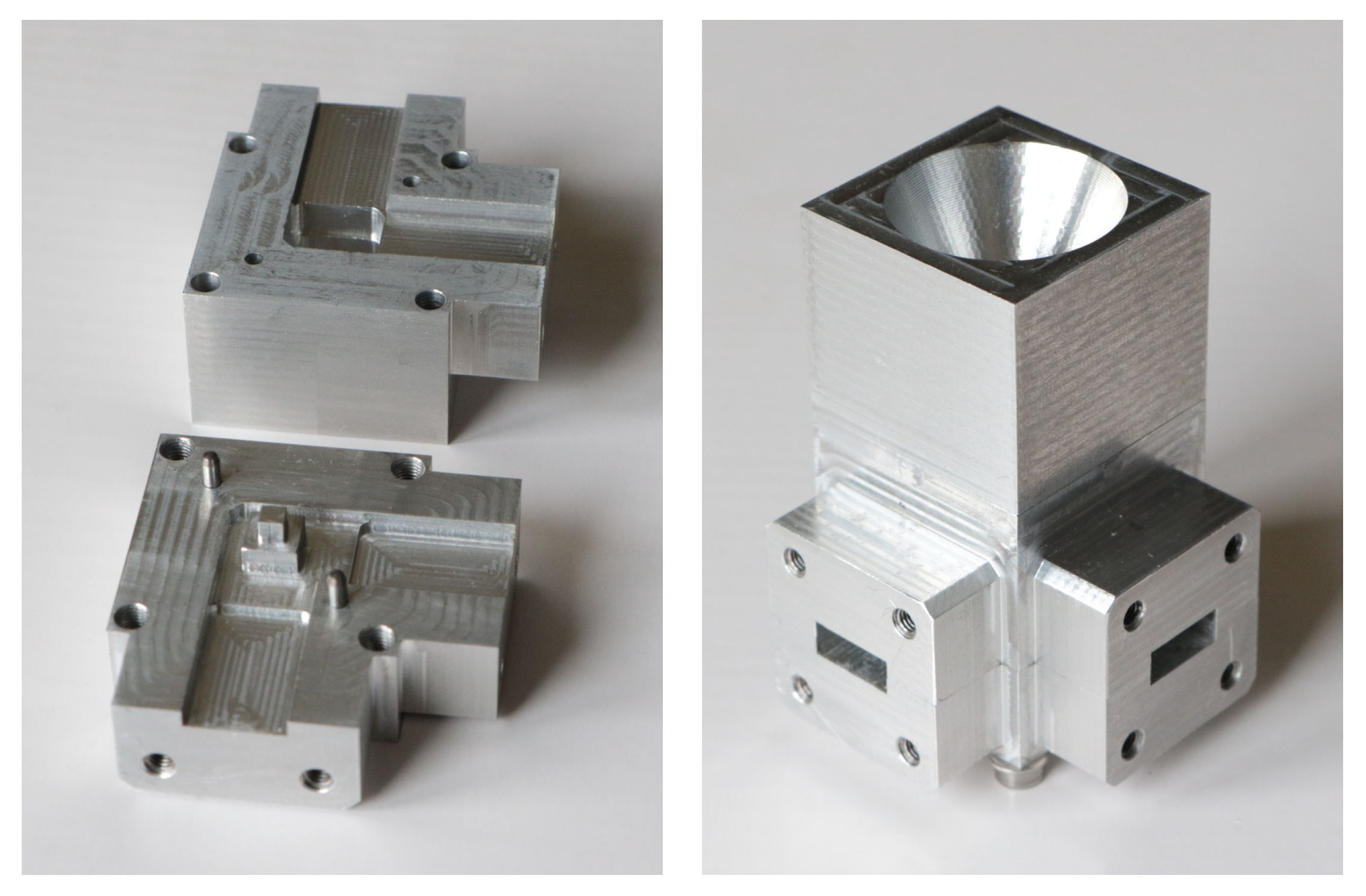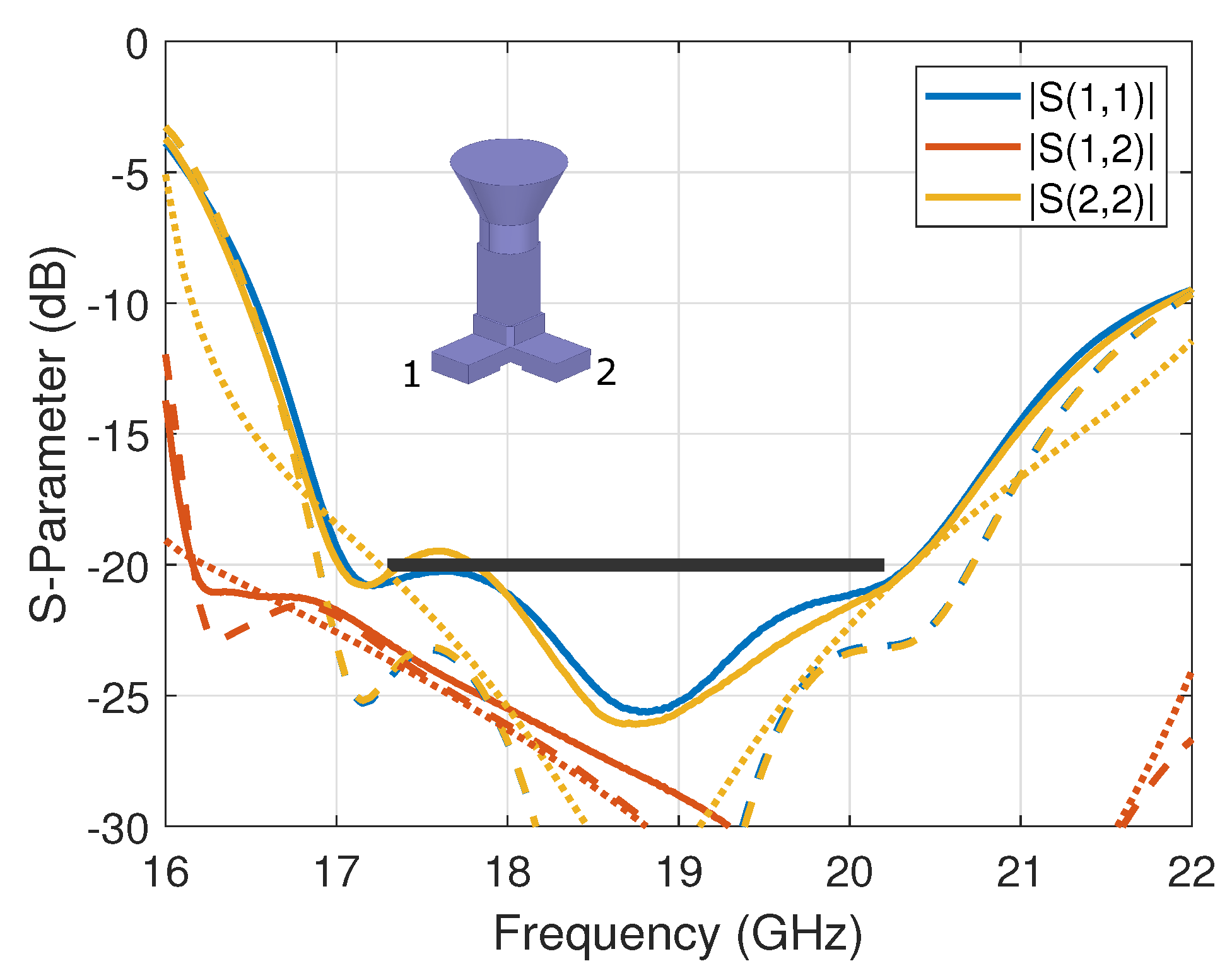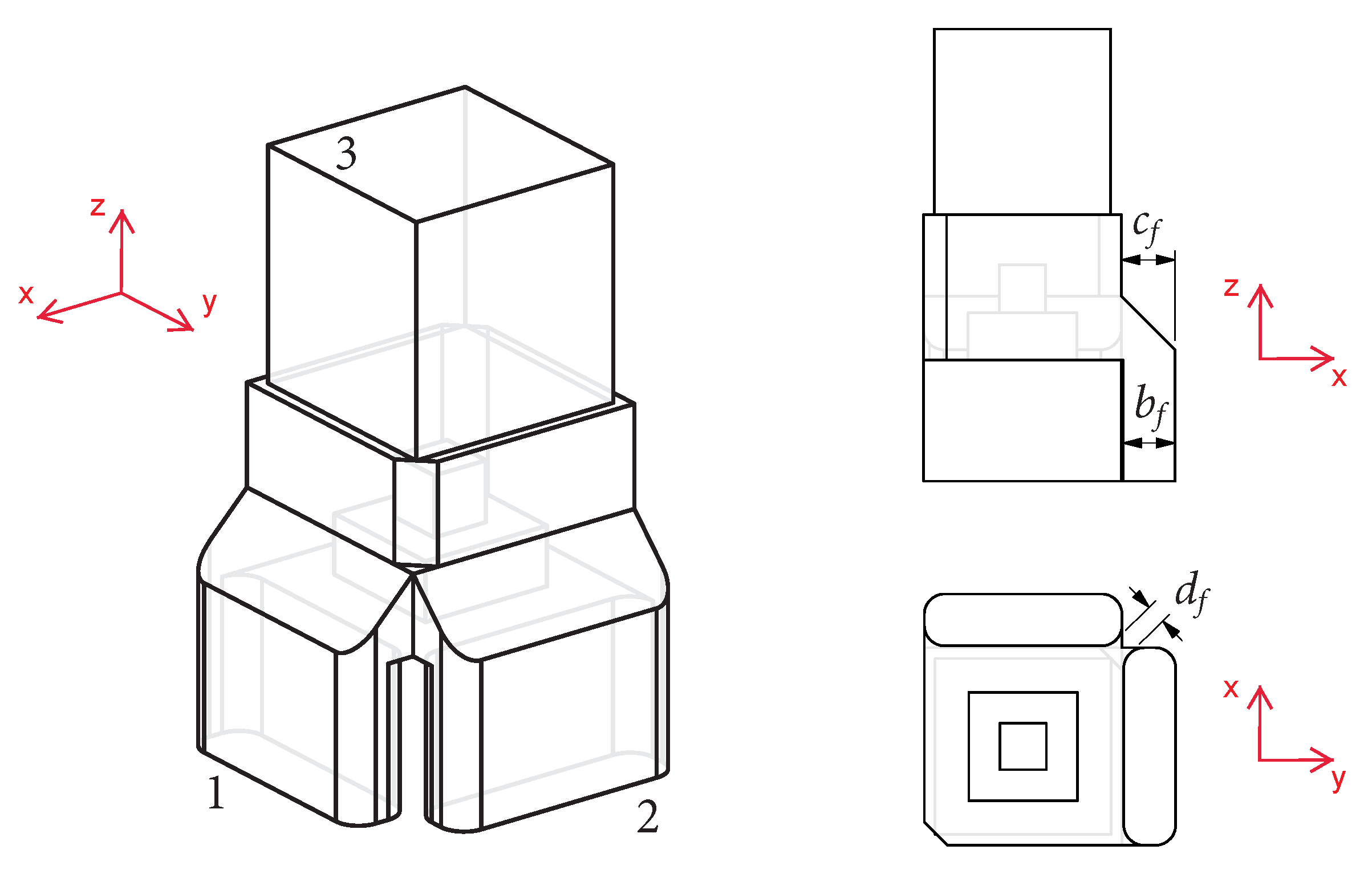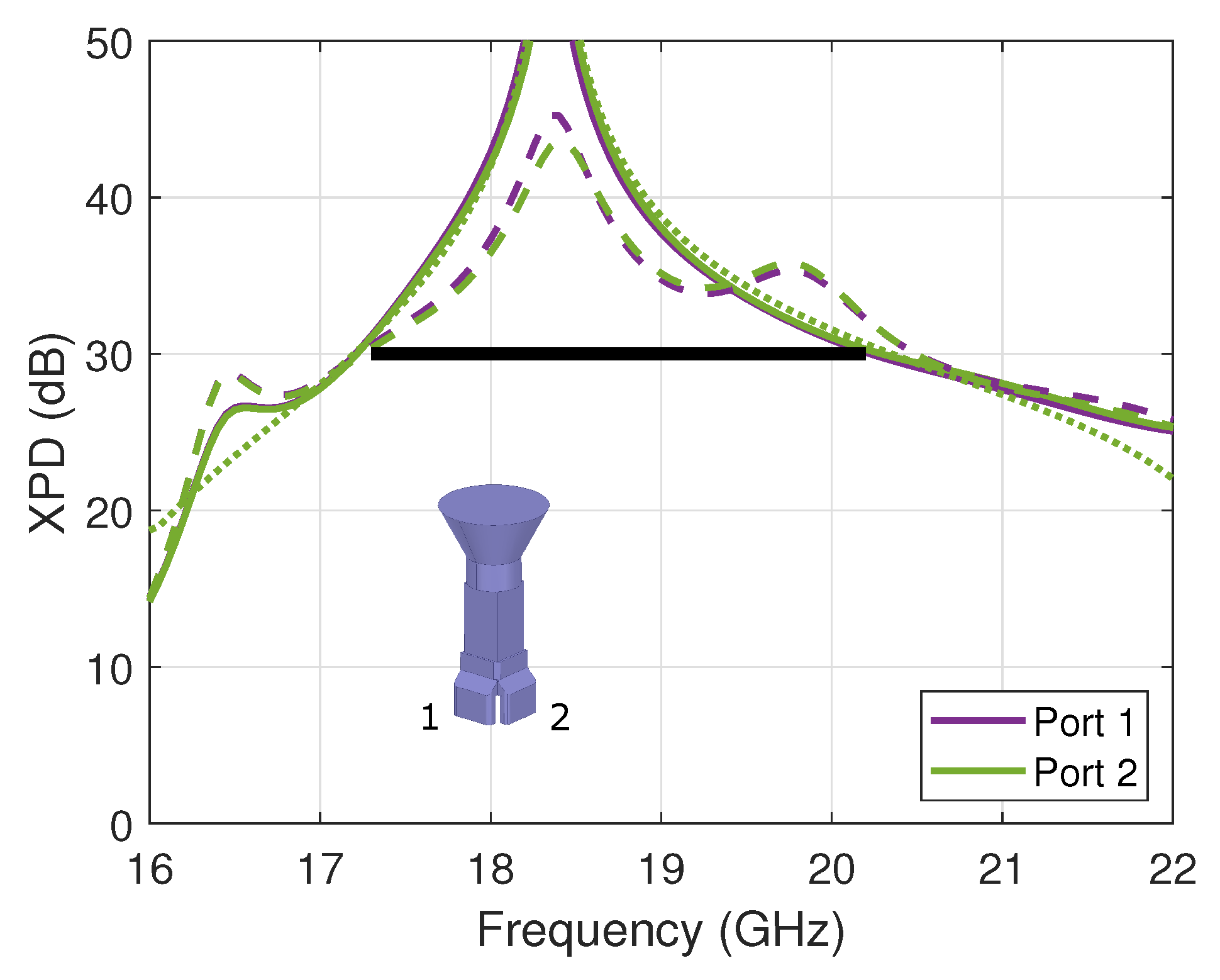Very Compact Waveguide Orthomode Transducer in the K-Band for Broadband Communication Satellite Array Antennas
Abstract
1. Introduction
- The probing waveguides can be folded [20], providing a design compatible with additive manufacturing constraints when printing along the longitudinal axis of the common waveguide.
2. Very Compact Waveguide OMT
2.1. Design Description
2.2. Experimental Results
3. Very Compact Waveguide OMT with Folded Ports
4. Conclusions
Funding
Institutional Review Board Statement
Informed Consent Statement
Data Availability Statement
Acknowledgments
Conflicts of Interest
References
- Fonseca, N.J.G.; Angevain, J.-C.; Mangenot, C. Toward the terabit/s satellite: Antenna design trade-offs and analyses. In Proceedings of the 33rd ESA Antenna Workshop, Noordwijk, The Netherlands, 18–21 October 2011; pp. 1–8. [Google Scholar]
- Palacin, B.; Fonseca, N.J.; Romier, M.; Contreres, R.; Angevain, J.C.; Toso, G.; Mangenot, C. Multibeam antennas for very high throughput satellites in Europe: Technologies and trends. In Proceedings of the 2017 11th European Conference on Antennas and Propagation (EUCAP), Paris, France, 19–24 March 2017; pp. 2413–2417. [Google Scholar]
- Fonseca, N.J.G. Recent patents on waveguide orthomode transducers. Recent Pat. Elect. Eng. 2010, 3, 133–143. [Google Scholar] [CrossRef]
- Tompkins, R.D. A Broad-Band Dual-Mode Circular Waveguide Transducer. IRE Trans. Microw. Theory Technol. 1956, 4, 181–183. [Google Scholar] [CrossRef]
- Steffe, W. A novel compact OMJ for Ku band Intelsat applications. In Proceedings of the IEEE Antennas and Propagation Society International Symposium, Newport Beach, CA, USA, 18–23 June 1995; pp. 152–155. [Google Scholar]
- Ludovico, M.; Piovano, B.; Bertin, G.; Zarba, G.; Accatino, L.; Mongiardo, M. CAD and optimization of compact ortho-mode transducers. IEEE Trans. Microw. Theory Technol. 1999, 47, 2479–2486. [Google Scholar] [CrossRef]
- Shang, X.; Klasmann, P.; Lancaster, M.J. A compact Ka-band waveguide orthomode transducer fabricated by 3-D printing. In Proceedings of the 2016 46th European Microwave Conference (EuMC), London, UK, 4–6 October 2016; pp. 365–368. [Google Scholar]
- Rosenberg, U.; Beyer, R. Compact T-junction orthomode transducer facilitates easy integration and low cost production. In Proceedings of the 2011 41st European Microwave Conference, Manchester, UK, 10–13 October 2011; pp. 663–666. [Google Scholar]
- Gerhardt, L.; de Castro, F.C.C.; Müller, C.; de Castro, M.C.F. Compact Symmetric Opposed Port Orthomode Transducer. IEEE Microw. Wirel. Comp. Lett. 2019, 29, 471–473. [Google Scholar] [CrossRef]
- Wu, Q.; Fan, C.; Yang, Y.; Shi, X. Ultra-compact taper branching orthomode transducer. Int. J. RF Microw. Aided Eng. 2020, 30, e22215. [Google Scholar] [CrossRef]
- Montejo-Garai, J.R.; Ruiz-Cruz, J.A.; Rebollar, J.M. Additive manufacturing of a compact Ku-band orthomode transducer. Int. J. Electr. Commun. 2021, 137, 153798. [Google Scholar] [CrossRef]
- Schneider, M.; Hartwanger, C.; Kilian, M. Antenna Concepts and Technologies for Future 5G Satellites. In Proceedings of the IEEE 2nd 5G World Forum (5GWF), Dresden, Germany, 30 September–2 October 2019; pp. 619–622. [Google Scholar]
- Davis, D.; Digiondomenico, O.J.; Kempic, J. A new type of circularly polarized antenna element. In Proceedings of the 1967 Antennas and Propagation Society International Symposium, Ann Arbor, MI, USA, 7–19 October 1967; pp. 26–33. [Google Scholar]
- Chen, M.H.; Tsandoulas, G.N. A wide-band square-waveguide array polarizer. IEEE Trans. Antennas Propag. 1973, AP-21, 389–391. [Google Scholar] [CrossRef]
- Bornemann, J.; Labay, V.A. Ridge waveguide polarizer with finite and stepped-thickness septum. IEEE Trans. Microw. Theory Techn. 1995, 43, 1782–1787. [Google Scholar] [CrossRef]
- Fonseca, N.J.G.; Angevain, J.-C. C-band septum polarizers with polynomial profile and accurate axial ratio characterization in back-to-back configuration. IEEE J. Microw. 2022, 2, 678–689. [Google Scholar] [CrossRef]
- Sarasa, P.; Diaz-Martin, M.; Angevain, J.-C.; Mangenot, C. New compact OMT based on a septum solution. In Proceedings of the 5th European Conference on Antennas and Propagation (EUCAP), Rome, Italy, 11–15 April 2011; pp. 1181–1185. [Google Scholar]
- Hozouri, B.T. Orthomode Transducer. U.S. Patent 9,947,978, 17 April 2018. [Google Scholar]
- Wolf, H.; Schneider, M. Orthomode Coupler for an Antenna System. U.S. Patent 9,478,838, 25 October 2016. [Google Scholar]
- Ruiz-Cruz, J.A.; Montejo-Garai, J.R.; Leal-Sevillano, C.A.; Rebollar, J.M. Orthomode Transducers With Folded Double-Symmetry Junctions for Broadband and Compact Antenna Feeds. IEEE Trans. Antennas Propag. 2018, 66, 1160–1168. [Google Scholar] [CrossRef]
- Chang, C.; Church, S.; Tantawi, S.; Voll, P.; Sieth, M.; Devaraj, K. Theory and experiment of a compact waveguide dual circular polarizer. Prog. Electromagn. Res. 2012, 131, 211–225. [Google Scholar] [CrossRef]
- Litun, V.; Ovechkin, V.; Golubstov, M. Theory and experiment of a compact waveguide polarization diplexer. In Proceedings of the 2019 PhotonIcs & Electromagnetics Research Symposium-Spring (PIERS-Spring), Rome, Italy, 17–20 June 2019. [Google Scholar]
- Fonseca, N. Waveguide Component for Use in an Orthomode Junction or an Orthomode Transducer. European Patent Application EP2019/079563, 29 October 2019. [Google Scholar]
- Fonseca, N.J.G. Compact Two-Probe Waveguide Orthomode Transducer With Twofold Rotational Symmetry. IEEE Trans. Microw. Theory Tech. 2021, 69, 3228–3235. [Google Scholar] [CrossRef]
- Fonseca, N.J.G.; Mangenot, C. High-performance electrically thin dual-band polarizing reflective surface for broadband satellite applications. IEEE Trans. Antennas Propag. 2016, 64, 640–649. [Google Scholar] [CrossRef]
- Naseri, P.; Matos, S.A.; Costa, J.R.; Fernandes, C.A.; Fonseca, N.J. Dual-band dual-linear-to-circular polarization converter in transmission mode application to K/Ka-band satellite communications. IEEE Trans. Antennas Propag. 2018, 66, 7128–7137. [Google Scholar] [CrossRef]
- Mercader-Pellicer, S.; Tang, W.; Bresciani, D.; Legay, H.; Fonseca, N.J.; Goussetis, G. Angularly Stable Linear-to-Circular Polarizing Reflectors for Multiple Beam Antennas. IEEE Trans. Antennas Propag. 2021, 69, 4380–4389. [Google Scholar] [CrossRef]
- Fonseca, N.J.G. Broadband Waveguide Dual-Polarization Four-Way Power Divider for Small Passive Arrays. IEEE Microw. Wirel. Comp. Lett. 2021, 31, 985–988. [Google Scholar] [CrossRef]







| Parameter | Value (mm) | Parameter | Value (mm) | Parameter | Value (mm) |
|---|---|---|---|---|---|
| 10.668 | 5.86 | 2.54 | |||
| 4.318 | 2.50 | 2.60 | |||
| a | 9.50 | 3.18 | 3.45 | ||
| z | 4.40 | c | 1.25 |
| Parameter | Value (mm) | Parameter | Value (mm) | Parameter | Value (mm) |
|---|---|---|---|---|---|
| z | 4.15 | 5.73 | 2.50 | ||
| c | 1.16 | 2.63 | 2.49 | ||
| 2.80 | 2.90 | 1.05 |
| Reference | Type | Footprint (xy-Plane) | Length (z-Axis) | Manufacturing Complexity | Fractional Bandwidth | Return Loss | Port-to-Port Coupling | XPD |
|---|---|---|---|---|---|---|---|---|
| [4,5,6,7] | Side coupling | Simple to moderate | 20–30% | >24 dB | <−50 dB | >50 dB | ||
| [8,9,10,11] | Opposing ports | Moderate | 20–30% | >20 dB | <−40 dB | Not reported | ||
| [17,18] | 180 septum | Simple to moderate | 5–10% | >25 dB | <−35 dB | >35 dB | ||
| [19] | 90 septum and iris | Simple to moderate | 20% | >22 dB | <−22 dB | >30 dB | ||
| [21,22] | Two-probe transversal | High due to small features | 10–15% | >20 dB | <−22 dB | >26 dB | ||
| This work | Two-probe transversal | Simple to moderate | 15–20% | >19 dB | <−22 dB | >30 dB |
Disclaimer/Publisher’s Note: The statements, opinions and data contained in all publications are solely those of the individual author(s) and contributor(s) and not of MDPI and/or the editor(s). MDPI and/or the editor(s) disclaim responsibility for any injury to people or property resulting from any ideas, methods, instructions or products referred to in the content. |
© 2023 by the author. Licensee MDPI, Basel, Switzerland. This article is an open access article distributed under the terms and conditions of the Creative Commons Attribution (CC BY) license (https://creativecommons.org/licenses/by/4.0/).
Share and Cite
Fonseca, N.J.G. Very Compact Waveguide Orthomode Transducer in the K-Band for Broadband Communication Satellite Array Antennas. Sensors 2023, 23, 735. https://doi.org/10.3390/s23020735
Fonseca NJG. Very Compact Waveguide Orthomode Transducer in the K-Band for Broadband Communication Satellite Array Antennas. Sensors. 2023; 23(2):735. https://doi.org/10.3390/s23020735
Chicago/Turabian StyleFonseca, Nelson J. G. 2023. "Very Compact Waveguide Orthomode Transducer in the K-Band for Broadband Communication Satellite Array Antennas" Sensors 23, no. 2: 735. https://doi.org/10.3390/s23020735
APA StyleFonseca, N. J. G. (2023). Very Compact Waveguide Orthomode Transducer in the K-Band for Broadband Communication Satellite Array Antennas. Sensors, 23(2), 735. https://doi.org/10.3390/s23020735






